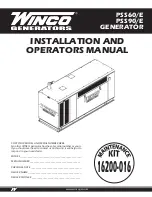
8
OPM-117/B
FUEL PRESSURE
Correct fuel pressure cannot be stressed enough. The most
common cause for inoperative systems is an inadequate
or incorrect fuel pressure. Performance of the engine is in
direct relation to the correctness of the fuel system. Shown
below is a diagram of a typical LP vapor fuel installation.
Notice the following tables give two different units of
measuring fuel pressure. The first and most accurate is
the use of a simple water manometer. A manometer is
calibrated in inches of water column . The second is with a
pressure gauge calibrated in ounces per square inch.
Reference numbers 1 through 3 in the diagram above are
system parts supplied by the customer. Reference number 4
is on the generator.
The following diagram is of a natural gas (NG) installation.
Reference numbers 2 through 4 in the previous diagram
are system parts supplied by the customer. Reference
number 4 is on the generator.
LP TANK SIZING
Tank Temperature
PSS60 Tank Size
PSS90 Tank Size
60° F (16° C)
500 Gallons
1000 Gallons
32° F (0° C)
1000 Gallons
1000 Gallons
0° F (18° C)
2000 Gallons
2000 Gallons
-20° F (-29° C)
5000 Gallons
5000 Gallons
LIQUID WITHDRAWAL SYSTEMS
When installing a unit equipped with the LP liquid
withdrawal, a primary regulator is not required on the
supply tank. The supply line is connected to a liquid
withdrawal valve on the supply tank and runs directly to
the fuellock strainer mounted on the engine generator
set. Normally a 3/8 to 1/2 inch copper line is acceptable
for this type of fuel installation. You must be sure that the
valve you have connected to on the supply tank is in fact a
liquid supply valve and has a drop tube inside the tank that
is pulling fuel from the bottom of the supply tank. Before
starting the unit, you must confirm that you have a good
liquid supply at the unit. Engine generator sets equipped for
liquid withdrawal will not run properly when supplied with
vapor fuel.
NATURAL GAS (NG)
The primary regulator (fuel meter) on the building should
deliver the correct volume and pressure to the generator
set. This regulator must be sized to deliver the required
BTU’s to the generator set and all other appliances in the
building. If the primary regulator (fuel meter) is a high
pressure regulator, then a low pressure regulator must be
installed to bring the pressure down to 4-6 oz. (7-11 inches
water column) of pressure. This low pressure regulator must
be at least 10 feet from the engine generator set; any closer
installation will require a larger line be installed to provide
a fuel reservoir. If this is not done, the demand regulator
on the unit and the pressure regulator in the fuel line will
interfere with each other. This regulator must be sized to
accommodate the demand of the generator set and any
other appliance connected to it. See the following table for
the correct size of pipe to be installed.
Feet*
Size of pipe
Up to 25 ft
1.25” pipe
Over 25 ft**
1.25” pipe
*Allow an additional 3 feet for each standard elbow.
** Not recommended for the PSS60
DO NOT use ‘street ells’ (restrictive).
WARNING: PERSONAL DANGER
Do not use galvanized pipe in fuel line runs. The galvanized
coating can become eroded and flake off, causing possible
obstructions in the regulator or fuel valve. The results could
range from inoperative engine to hazardous fuel leaks.
CAUTION:
Be careful when sealing gas joints. Excessive sealing
compound can be drawn into the solenoid, regulator or
carburetor causing an engine malfunction.






































